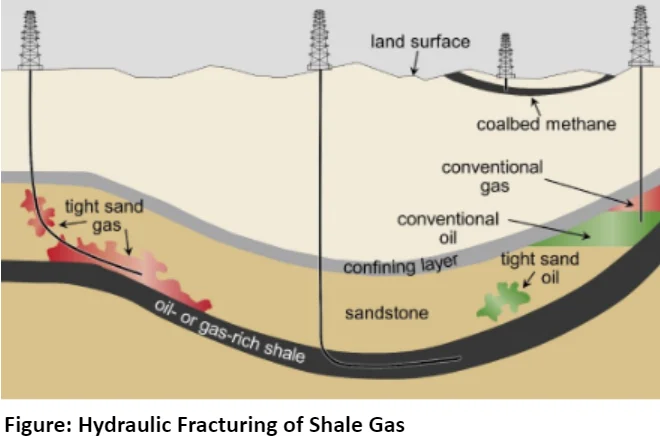With conventional hydrocarbons facing depletion, unconventional sources have gained prominence, necessitating advanced extraction technologies. These unconventional hydrocarbons, like shale gas and coalbed methane, are trapped in low-permeability formations, demanding specialized recovery methods. India, endowed with substantial reserves, particularly in shale gas and coal bed methane, stands poised to harness these resources to meet its energy needs.
India’s Potential in Unconventional Hydrocarbons
- Shale gas and coalbed methane are trapped in low-permeability rock formations, requiring specialized technologies.
- India’s potential:
- Shale gas: NITI Aayog estimates India’s recoverable shale gas resources at 96 Tcf, with potential in six basins.
- Coal Bed Methane: India has vast CBM reserves in 12 states, offering a clean and efficient source of energy;
- Fifth-largest proven reserves globally, estimated at around 92 Tcf (2600 BCM).
| Shale gas is the natural gas that is trapped within shale formations; Distribution: Cambay Basin, Cauvery Basin, Krishna-Godavari Basin, Assam – Arakan; Gondwana basin (including Damodar). [UPSC 2016] |
A. Coal-Bed Methane
- Coal bed methane (CBM): It is also known as coal seam gas, and is a natural gas trapped within coal seams. It’s often referred to as “marsh gas” in coal mining. Comprising mainly CH4 (>95%), with minor C2H6, C3H8, N2, and CO2.
- CBM, predominantly CH4, is stored in coal beds in an adsorbed state.
- Occurrence: It’s found on coal grain surfaces as absorbed gas and in cleats/fractures as free gas or dissolved in water.
- Occurring in coal beds, CBM lacks a clear trap definition.
- CBM shares similarities with conventional natural gas but differs in occurrence and enrichment conditions.
- Formation: It forms over millions of years as organic matter decomposes and releases methane, which gets adsorbed onto the coal’s internal surface.
- India’s CBM: estimated 92 TCF (2600 BCM) recoverable CBM resources in India.
- Key Regions: Damodar Valley, Son Valley, and Godavari Basin.
B. Shale Gas
-
- Meaning: Shale is a compressed, fine-grained sedimentary rock that originated from the compaction of mud, silt, clay, and organic materials.
- Formation: Shale gas, produced over millions of years as organic matter decomposes within shale, is trapped in the rock’s pores and fractures.
- Hydraulic Fracturing: Unlike conventional gas, it requires hydraulic fracturing, or “fracking,” for extraction.
- Fracturing fluid is injected into the drilling pipe at high pressure (around 100 bar).
-
-
- The fluid primarily consists of water.
- Quartz sand is commonly mixed with the fluid.
- Various chemicals are also added in the fluid.
-
-
- North America: US leads in recoverable shale gas; Canada follows closely.

-
-
- Reserves: 96 TCF estimated; spread across six basins.
- Key Basins: Cambay, Assam-Arakan, Gondwana, Krishna Godavari, Cauvery, Indo-Gangetic.
- Disadvantages: Large volumes of water are used, leading to contamination from underground layers.
-
- Fractures: in rock formations can extend into deeper layers.
- Radon and mercury gases may escape from shale formations.
- Small Earthquakes: Induced seismic activity can occur due to changes in rock forces.
C. Gas Hydrate
- Gas hydrates are seen as a potential future energy source globally.
- Composition: It is a solid made of gas molecules trapped in water. Each molecule of Gas hydrate contains up to 164 m3 of Methane (CH4)
- Global Efforts: Production from gas hydrates is currently in the research and development stage worldwide.
- Countries like the USA, Japan, Russia, China, Germany, and Korea are actively involved in developing extraction technologies.
- In India: research and exploration of gas hydrates are led by the Ministry of Petroleum & Natural Gas through the National Gas Hydrate Program (NGHP).
- Initial work in India on Gas Hydrates as an energy resource was done by GAIL and NIO.
- The government has agreements with other organizations to share information and data for gas hydrate research.
- Occurrence in India: Gas hydrate presence is confirmed in regions like Krishna Godavari, Mahanadi, Gulf of Mannar, and Andaman Basin.
| Mines and Minerals (Development and Regulation) (MMDR) Act, 1957, State Governments have the power to frame rules to grant mining leases of minor minerals. State government also has the power to frame rules to prevent illegal mining of minor minerals. [UPSC 2019] |
Conclusion
Unconventional hydrocarbons like shale gas and coalbed methane are vital energy sources as conventional hydrocarbons deplete. India has significant potential in these resources, particularly in shale gas and coalbed methane, found across various basins. Shale gas extraction requires hydraulic fracturing, while coalbed methane is extracted through specialized recovery methods. Gas hydrates, though in the research phase, also hold potential as future energy sources.
![]() May 4, 2024
May 4, 2024
![]() 2233
2233
![]() 0
0
